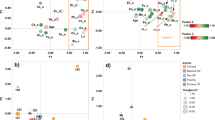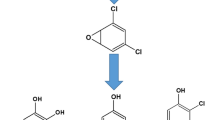Summary
Personal monitoring of exposure to tetrachloroethylene (TETRA) with carbon felt dosimeters and analyses of urine for total trichloro-compounds (TTC) were carried out in two groups of workers (36 males and 25 females), one group (20 males and 19 females) in dry-cleaning workshops and the other (16 males and 6 females) engaged in the removal of glue from silk cloth. Comparison of the urinary TTC levels with TETRA in the environment revealed that, while the metabolite levels increased essentially linear to TETRA concentrations up to 100 ppm, leveling off was apparent in the metabolite excretion when the exposure to TETRA was more intense (e.g. more than 100 ppm), indicating that the capacity of humans to metabolize TETRA is rather limited, as previously discussed. From the set of the data thus obtained, screening levels of 30 and 61 mg TTC (as TCA)/l urine as the lower 95% confidence limits for a group mean were calculated for the biological monitoring, by means of urinalysis, of exposure to TETRA at 50 and 100 ppm (TWA), respectively. A tentative calculation with additional exhaled-air analyses indicated that, at the end of an 8-h shift with exposure to TETRA at 50 ppm (TWA), 38% of the TETRA absorbed through the lungs would be exhaled unchanged and less than 2% would be metabolized to be excreted into the urine, while the rest would remain in the body to be eliminated later.
Similar content being viewed by others
References
American Conference of Governmental Industrial Hygienists (1981) Threshold limit values for chemical substances in workroom air adopted by ACGIH for 1981, ACGIH, Cincinnati, Ohio 45211, USA
Bonse G, Urban Th, Reichert D, Henschler D (1975) Chemical reactivity, metabolic oxirane formation and biological reactivity of chlorinated ethylenes in the isolated perfused rat liver preparation. Biochem Pharmacol 24:1829–1834
Costa AK, Ivanetich KM (1980) Tetrachloroethylene metabolism by the hepatic microsomal cytochrome P-450 system. Biochem Pharmacol 29:2863–2869
Fernandez J, Guberan E, Caperos J (1976) Experimental human exposures to tetrachloroethylene vapor and elimination in breath after inhalation. Am Ind Hyg Assoc J 37:143–150
Fukabori S (1970) The concentration of methyl chloroform in expired air of man after exposure (in Japanese with an English abstract). Rodo Kagaku (J Sci Labour) 46:535–543
Hake CL, Stewart RD (1977) Human exposure to tetrachloroethylene: Inhalation and skin contact. Environ Health Perspect 21:231–238
Hirayama T, Ikeda M (1979) Applicability of carbon felt to the dosimetry of solvent vapor mixture. Am Ind Hyg Assoc J 40:1091–1096
Ikeda M, Imamura T (1973) Biological half-life of trichloroethylene and tetrachloroethylene in human subjects. Int Arch Arbeitsmed 31:209–224
Ikeda M, Koizumi A, Miyasaka M, Watanabe T (1982) Styrene exposure and biological monitoring in FRP boat production plants. Int Arch Occup Environ Health 49:325–339
Ikeda M, Ohtsuji H (1969) Hippuric acid, phenol and trichloroacetic acid levels in the urine of Japanese subjects with no known exposure to organic solvents. Br J Ind Med 26:162–164
Ikeda M, Ohtsuji H (1972a) A comparative study of the excretion of Fujiwara reaction-positive substances in urine of humans and rodents given trichloro- or tetrachloro-derivatives of ethane and ethylene. Br J Ind Med 29:99–104
Ikeda M, Ohtsuji H, Imamura T, Komoike Y (1972b) Urinary excretion of total trichloro-compounds, trichloroethanol and trichloroacetic acid as a measure of exposure to trichloroethylene and tetrachloroethylene. Br J Ind Med 29:328–333
Imamura T, Ikeda M (1973) Lower fiducial limit of urinary metabolite level as an index of excessive exposure to industrial chemicals. Br J Ind Med 30:289–292
International Agency for Research on Cancer (1979a) Tetrachloroethylene. IARC Monographs on the Evaluation of the Carcinogenic Risk of Chemicals to Humans 20:491–514
International Agency for Research on Cancer (1979b) Vinyl chloride, polyvinyl chloride and vinyl chloride-vinyl acetate copolymers. IARC Monographs on the Evaluation of the Carcinogenic Risk of Chemicals to Humans 19:377–438
Jackson S (1966) Creatinine in urine as an index of urinary excretion rate. Health Phys 12:843–850
Japanese Association of Industrial Health (1981) Recommended occupational exposure limits. Jpn J Ind Health 23:565–576
Koizumi A, Hirayama S, Shiojima S, Ikeda M (1980) Evaluation of carbon felt dosimetry in comparison with one-shot air sampling method and biological monitoring: A field survey. Ind Health 18:153–163
Koizumi A, Ikeda M (1981) A servomechanism for vapor concentration control in experimental exposure chambers. Am Ind Hyg Assoc J 42:417–425
Leibman KC, Ortiz E (1977) Metabolism of halogenated ethylenes. Environ Health Perspect 21:91–97
Monster AC (1979a) Difference in uptake, elimination and metabolism in exposure to trichloroethylene, 1,1,1-trichloroethane and tetrachloroethylene. Int Arch Occup Environ Health 42:311–317
Monster AC, Boersma G, Steenweg H (1979b) Kinetics of tetrachloroethylene in volunteers; influence of exposure concentration and work load. Int Arch Occup Environ Mealth 42:303–309
National Cancer Institute (1977) Bioassay of tetrachloroethylene for possible carcinogenicity. National Cancer Institute Technical Report Series No. 13, NCI-CG-TR-13
Nomiyama K, Nomiyama H (1974) Respiratory retention, uptake and excretion of organic solvents in man. Int Arch Occup Environ Health 32:75–83
Ogata M, Takatsuka Y, Tomokuni K (1971) Excretion of organic chlorine compounds in the urine of persons exposed to vapours of trichloroethylene and tetrachloroethylene. Br J Ind Med 28:386–391
Ohta T, Morita M, Mizoguchi I (1976) Local distribution of chlorinated hydrocarbons in the ambient air in Tokyo. Atmospheric Environment 10:557–560
Rainsford SG, Lloyd Davis TA (1965) Urinary excretion of phenol by men exposed to vapour of benzene; a screening test. Br J Ind Med 22:21–26
Riihimäki V, Pfäffli P (1978) Percutaneous absorption of solvent vapors in man. Scand J Work Environ Health 4:73–85
Roach SA (1966) A more rational basis for air sampling programs. Am Ind Hyg Assoc J 27:1–12
Stewart RD, Baretta ED, Dodd HC, Torkelson TR (1970) Experimental human exposure to tetrachloroethylene. Arch Environ Health 20:224–229
Tanaka S, Ikeda M (1968) A method for determination of trichloroethanol and trichloroacetic acid in urine. Br J Ind Med 25:214–219
Verberk MM, Scheffers TML (1980) Tetrachloroethylene in exhaled air of residents near dry-cleaning shops. Environ Res 21:432–437
Yllner S (1961) Urinary metabolites of 14C-tetrachloroethylene in mice. Nature (Lond) 191:820 only
Ziglio G (1981) Human exposure to environmental trichloroethylene and tetrachloroethylene: Preliminary data on population group of Milan, Italy. Bull Environ Contam Toxicol 26:131–136
Author information
Authors and Affiliations
Rights and permissions
About this article
Cite this article
Ohtsuki, T., Sato, K., Koizumi, A. et al. Limited capacity of humans to metabolize tetrachloroethylene. Int. Arch Occup Environ Heath 51, 381–390 (1983). https://doi.org/10.1007/BF00378352
Received:
Accepted:
Issue Date:
DOI: https://doi.org/10.1007/BF00378352




